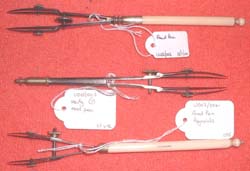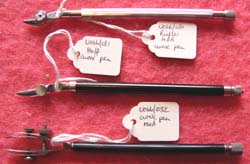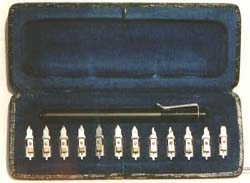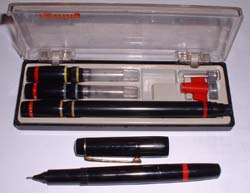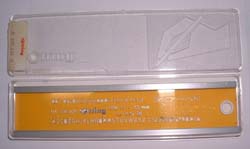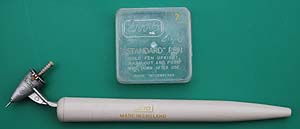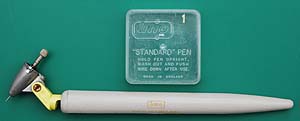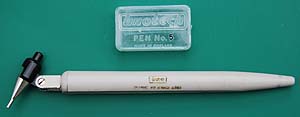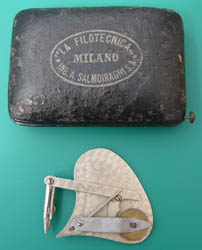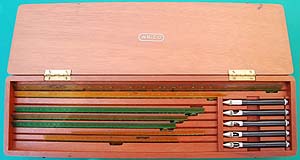












The drawing pens in the collection consist mainly of two basic types, bow pens and tubular nib pens. There are also a few pens for lettering for which draughtsmen often used the crow quill type, and a pen for drawing the lines for music.

Two English ruling pens. The first dates from the late eighteenth century. The brass handle unscrews halfway along its length to reveal a protracting pin (used for marking out). The hand-made wing screw for adjusting the line width is typical of this period. The second, early nineteenth century pen is of the 'split' type. When the brass cap is unscrewed and the adjusting screw is removed the two halves open like a pair of scissors to enable the pen to be cleaned.
An unusual English ruling pen, probably dating to around 1830. In appearance it is like the ‘split’ type pen above, but in this case only the lower half of the pen pivots to open for cleaning and the cap cannot be unscrewed.
By the middle of the nineteenth century ivory handles had become the norm for all better quality British made pens. These two pens are from a 1930s Halden Premier set but differ very little from those produced nearly 100 years before. The upper pen has an opening nib, made partly of electrum & partly of steel. The lower one is a fine line pen with a narrowly pointed steel nib.
Ruling pen from a Compassi di Milano set. A typical Italian, brass handled, steel pen, probably late nineteenth century. The bottom leaf of the pen is hinged to open downwards.
This early twentieth century border pen was used for drawing thick lines. It was retailed by Drawing Office Supplies of London.
Two dotted line pens. The upper one is of British manufacture by Harling. It is capable of producing three different types of line. The wheel can be changed and spare ones are held in the ivory box at the end of the handle. There is quite a large ink reservoir above the wheel. The lower one is much simpler and is probably French as the handle is characteristically one of their forms.
This pen, possibly made in Germany, is known as a detail pen. It has a line thickness setting scale on the adjusting wheel.
Three road pens for drawing parallel lines. The upper one appears to be Foreign, possibly French. The middle one is mid nineteenth century and constructed from steel in a similar fashion to the 'split' pen at (1) above. The third dates from about 1900 and was made by Reynolds of Birmingham.
See the 1851 edition of J F Heather for a contemporary picture of the 'split' type.
Three curved line pens. The knob at the end of the handle, if unscrewed slightly, allows the head of the pen to swivel and follow a curve. The first is a Riefler 40A, the second is by Haff of Germany, and the third is a curve road pen.
A pen with five interchangeable nibs which screw onto the handle.
Pelikan Graphos pen set. There are twelve nibs in the set, each giving a different line width. These pens were mainly used by graphic designers. It was made in Germany.
Pens with tubular nibs revolutionised drawing in ink. One fill of the reservoir would suffice for a whole session and the line width was guaranteed by choosing the right size pen. The British made UNO was one of the first tubular nib pens. The photograph shows an example of their 'de-luxe' model. Used with a stencil they could also produce even, readable lettering.
UNO CC3 stencil. Although tubular nib pens eased drawing in ink the user required a range of sizes as they were line width or lettering size specific. Hence the stencil has the size of the pen to be used with it printed on it.
Probably the best known tubular nib pen is the Rotring 'Variant'. This photograph shows a set of three Variant pens and a holder in a case. Each pen unit is for a different size of line and has its own ink reservoir. The red tool is for removing the nib from the pen unit for cleaning.
The same type of nib unit was also used in the 'Rapidograph' fountain pen, an example of which is shown below.
Rotring stencil for use with their pens.
Later type of Rotring stencil.
Standardgraph stencil. Although the stencil is very similar to the Rotring one the pen was more like the UNO one.
Standardgraph pen and holder with stand.
UNO Standard pen and holder. This was the basic type of pen. It was patented no. 416640 in 1934.
UNO Standard pen no. 2. Later type of Standard pen and holder, pen marked patent applied for. The number indicates the line width.
The next version of the UNO Standard pen, a no. 1. Marked with patent 885,395 (issued in 1961). The head now pivots.
Unotech pen no. 5, marked with patent 1.165,296 (issued in 1969)
“La Filotecnica” mechanical dotted line pen by Ing A Salmoiraghi S A, Milano. The pen is of the type patented by E O Richter.
WRICO pen and lettering guide ser made by the Wood Regan Instrument Co Inc of New York. Patented in 1926 the seven guides are celluloid and there are five pens.

A one stroke lettering pen for ½ inch wide lines, maker unknown, from a box of drawing instruments by B J Hall & Co Ltd.

A Barch Payzant lettering pen by Keuffel & Esser. A set of these can be seen on the Keuffel & Esser page.


Tubular nib pen made in Germany. The swivelling and retracting head is unusual. The nib unit has 56 stamped on it which is typical of the size codes used by Standardgraph. Did they make this pen?


This unusual pen is for drawing the lines for music and draws five lines at once. It is made of brass with a rosewood handle and an ivory finial that unscrews to reveal the blade used for placing ink in the bowl shaped reservoir. There is a hole between the reservoir and the ink channels so that it flows to the feeds at the writing end.

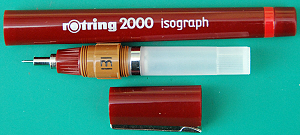


Rotring 2000 isograph technical pen for drawing and lettering. This featured a new
“hydrodynamic system” that was claimed to be an improvement compared to that used
in the Variant and Varioscript pens, It was available for a series of 9 line widths
to meet DIN and ISO standards. Introduced in 1978. As with other Rotring pens (except
for the Rapidograph and Graphos) the ink was placed in the removable translucent
reservoir.
Staedtler Marsmatic 700 pens were (and still are) available in a range of line widths
to meet DIN & ISO standards and, like the Rotring pens, have a removable ink reservoir
that has to be filled before use. The two pens shown are for 0.7 and 0.35mm line
widths.






French mechanical dotted line pen with ivory handle and nickel-silver body. The steel
spring that holds the pawl against the dotted line wheel has broken off and it is
missing a set of wheels for different dot patterns. One of these would fit behind
the brass driving wheel that runs along the rule edge.

Rotring Foliograph drawing pen with 0,5mm tubular nib, carbide tipped for use on
abrasive plastic film.
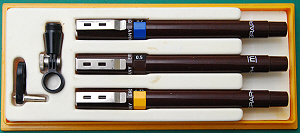
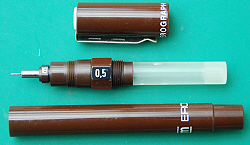
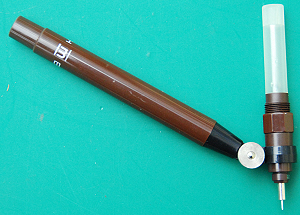
Erograph, Germany, Micronorm pen set containing 0.35, 0.5 and 0.7mm pens together
with a compass adaptor and a fitting to enable the pens to be used with the handle
inclined as shown in the third photo.
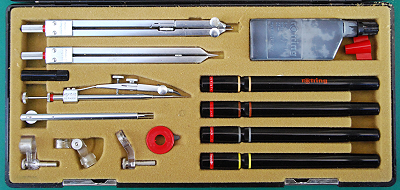

Rotring Variant set. Pens are 0.2, 0.3, 0.4 & 0.5 mm. The compasses were made by
Riefler for Rotring. The same compasses with minor variations can be seen in the
Wild System Riefler RZP31 set.







